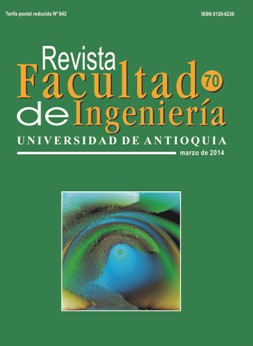Experimental Validation of Motor Current Signature Analysis for a 2HP Induction Motor
DOI:
https://doi.org/10.17533/udea.redin.18653Keywords:
fault detection, electric motors monitoring, MCSA, condition based maintenanceAbstract
The use of stator currents signal analysis for rotating electrical machines monitoring, particularly induction motors, has developed a growing interest, as the information contained in the spectrum of the current signal can indicate the presence of various types of both electrical and mechanical failures. In this work a test bed for induction motors 2 HP was implemented in order to validate the MCSA (Motor Current Signature Analysis) methodology, for the detection of: short circuit in the stator winding, broken rotor bars and eccentricity gap under different load conditions. Results show the dependency between the load level on the motor and the possibility to detect faults, and make possible to assess the feasibility of implementing MCSA methodology in of condition-based maintenance (CBM) schemes.
Downloads
References
O. Ojo, O. Osaloni, P. Kshirsagar. Models for the control and simulation of synchronous type machine drives under various fault conditions. Conference Record Ind. Applicat. Conf. 37th IAS Annual Meeting. Pittsburgh, USA. 2002. pp. 1533-1540.
M. Awadallah, M. Morcos. “ANFIS-based diagnosis and location of stator interturn faults in PM brushless DC motors”. IEEE Trans. Energy Conversion. Vol. 19. 2004. pp. 795-796. DOI: https://doi.org/10.1109/TEC.2004.837273
A. Bonnett, G. Soukup. “Cause and analysis of stator and rotor failures in three-phase squirrel-cage induction motors”. IEEE Trans. Ind. Appl. Vol. 28. 1992. pp. 921-937. DOI: https://doi.org/10.1109/28.148460
S. Nandi, H. Toliyat, Li. Xiaodong. “Condition monitoring and fault diagnosis of electrical motors-a review”. IEEE Trans. Energy Convers. Vol. 20. 2005. pp. 719-729. DOI: https://doi.org/10.1109/TEC.2005.847955
S. Williamson, K. Mirzoian. “Analysis of Cage Induction Motors with Stator Winding Faults.” IEEE Trans. Power App. Syst. Vol. PAS-104. 1985. pp. 1838- 1842. DOI: https://doi.org/10.1109/TPAS.1985.319221
W. Thomson. On-line MCSA to diagnose shorted turns in low voltage stator windings of 3-phase induction motors prior to failure. Electric Machines and Drives Conference. IEMDC 2001. IEEE International. Cambridge, USA. 2001. pp. 891-898.
F. Filipetti, G. Franceschini, C. Tassoni, P. Vas. AI techniques in induction machines diagnosis including the speed rifle effect. Conf. Rec. 34th IAS Annu. Meeting. San Diego, USA. 1996. pp. 655-662.
N. Elkasabgy, A. Eastham, G. Dawson. “Detection of broken bars in the cage rotor on an induction machine.” IEEE Trans. Ind. Appl. Vol. 22. 1992. pp. 165-171. DOI: https://doi.org/10.1109/28.120226
W. Thomson, M. Fenger. Industrial application of current signature analysis to diagnose faults in 3-phase squirrel cage induction motor. Pulp and Paper Industry Technical Conference 2000. Atlanta, USA. pp. 205-211.
F. Filippetti, G. Franceschini, C. Tassoni, P. Vas. AI techniques in induction machines diagnosis including the speed ripple effect. Industry Applications Conference. 31st IAS Annual Meeting. San Diego, USA. Vol. 1. 1996. pp. 655-662.
J. Cameron, W. Thomson, A. Dow. “Vibration and current monitoring for detecting airgap eccentricity in large induction motors.” Proc. Inst. Elect. Eng. B. Vol. 133. 1986. pp. 155-163. DOI: https://doi.org/10.1049/ip-b.1986.0022
D. Dorrell, W. Thomson, S. Roach. “Analysis of airgap flux, current, and vibration signals as a function of the combination of static and dynamic airgap eccentricity in 3-phase induction motors.” IEEE Trans. Ind. Appl. Vol. 33. 1997. pp. 24-34. DOI: https://doi.org/10.1109/28.567073
R. Obaid, T. Habetler, D. Gritter. A simplified technique for detecting mechanical faults using stator current in small induction motors. Ind Applicat Conf. 2000. Conference Record of the 2000 IEEE. Rome, Italy. Vol. 1. 2000. pp. 479-483.
Downloads
Published
How to Cite
Issue
Section
License
Copyright (c) 2018 Revista Facultad de Ingeniería

This work is licensed under a Creative Commons Attribution-NonCommercial-ShareAlike 4.0 International License.
Revista Facultad de Ingeniería, Universidad de Antioquia is licensed under the Creative Commons Attribution BY-NC-SA 4.0 license. https://creativecommons.org/licenses/by-nc-sa/4.0/deed.en
You are free to:
Share — copy and redistribute the material in any medium or format
Adapt — remix, transform, and build upon the material
Under the following terms:
Attribution — You must give appropriate credit, provide a link to the license, and indicate if changes were made. You may do so in any reasonable manner, but not in any way that suggests the licensor endorses you or your use.
NonCommercial — You may not use the material for commercial purposes.
ShareAlike — If you remix, transform, or build upon the material, you must distribute your contributions under the same license as the original.
The material published in the journal can be distributed, copied and exhibited by third parties if the respective credits are given to the journal. No commercial benefit can be obtained and derivative works must be under the same license terms as the original work.










 Twitter
Twitter